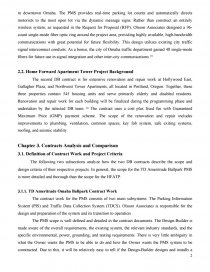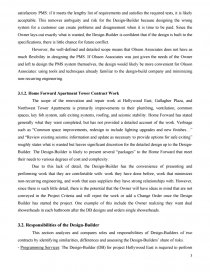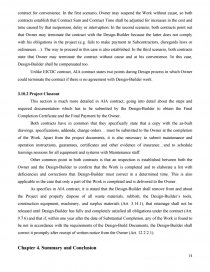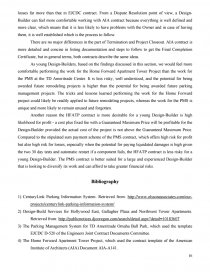Design-Build Contracts
Essay by mcastillanotario • May 20, 2017 • Presentation or Speech • 6,688 Words (27 Pages) • 1,103 Views
Contract Analysis Report
Chapter 1. Introduction
The purpose of this report is to analyze two design-build (DB) construction contracts in terms of responsibilities, authorities, liabilities, and risk sharing between all the stakeholders in the construction projects. Both analyzed contracts in this report use a different industry standard template. The first contract, The Parking Management System for TD Ameritrade Omaha Ball Park, uses the contract template EJCDC D-520 of the Engineers Joint Contract Documents Committee. The second contract, The Home Forward Apartment Tower Project (HFATP), uses the contract template of the American Institute of Architects (AIA) Document AIA-A141. This report compares between the plain texts of the contracts and the impacts and risks of the contracts clauses on the project stakeholders.
Initially, each team member read and annotated both contracts and then discussed their thoughts on the two contracts with the group. The introduction and background sections were written during several meetings that occurred, usually on the days in which class was canceled. After these initial discussions, the work for the final report was divided-up and completed as follows:
Introduction | Definition of Contract Work and Project Criteria | Responsibilities of the Design-Builder | Responsibilities of the Owner |
Projects Background | Project Time and Schedule | Changes in the Work | Dispute Resolution |
Conclusion and Summary | Payments and Compensation | Insurance and Risk Sharing | Project Closeout and Termination |
Bibliography | Awards of Subcontracts |
Once the individual work was completed, each member’s contribution was compiled, reviewed, and edited by the team until each member was satisfied with the final report.
Chapter 2. Projects Background
2.1. TD Ameritrade Omaha Ball Park Project Background
The first DB contract is between the City of Omaha, Nebraska and Olsson Associates, an engineering and design service provider. The contract calls for Olsson Associates to develop and install a Parking Management System (PMS) for the TD Ameritrade Omaha Ball Park as a lump-sum design build contract with a total cost of $907,553.00. The project consists of both an automated parking count system and a separate dynamic message sign system located in the greater stadium area in downtown Omaha. The PMS provides real-time parking lot counts and automatically directs motorists to the most open lot via the dynamic message signs. Rather than construct an entirely wireless system, as requested in the Request for Proposal (RFP), Olsson Associates designed a 96-count single-mode fiber optic ring around the project area, providing highly available, high-bandwidth communications with great potential for future flexibility. This design utilizes existing city traffic signal interconnect conduits. As a bonus, the city of Omaha traffic department gained 48 single-mode fibers for future use in signal integration and other inter-city communications. (1)
2.2. Home Forward Apartment Tower Project Background
The second DB contract is for extensive renovation and repair work at Hollywood East, Gallagher Plaza, and Northwest Tower Apartments, all located in Portland, Oregon. Together, these three properties contain 545 housing units and serve primarily elderly and disabled residents. Renovation and repair work for each building will be finalized during the programming phase and undertaken by the selected DB team. (2) The contract uses a cost plus fixed fee with Guaranteed Maximum Price (GMP) payment scheme. The scope of the renovation and repair includes improvements to plumbing, ventilation, common spaces, key fob system, safe exiting systems, roofing, and seismic stability.
Chapter 3. Contracts Analysis and Comparison
3.1. Definition of Contract Work and Project Criteria
The following two subsections analyze how the two DB contracts describe the scope and design criteria of their respective projects. In general, the scope for the TD Ameritrade Ballpark PMS is more detailed and thorough than the scope for the HFATP.
3.1.1. TD Ameritrade Omaha Ballpark Contract Work
The contract work for the PMS consists of two main subsystems: The Parking Information System (PIS) and Traffic Data Collection System (TDCS). Olsson Associates is responsible for the design and preparation of the system and its transition to operation.
The PMS scope is well defined and detailed in the contract documents. The Design-Builder is made aware of the overall requirements, the existing system, the relevant industry standards, and the specific environmental, power, grounding, and testing requirements. There is very little ambiguity in what the Owner wants the PMS to be able to do and how the Owner wants the PMS system to be constructed. Due to this, it will be relatively easy to tell if the Design-Builder designs and installs a satisfactory PMS: if it meets the lengthy list of requirements and satisfies the required tests, it is likely acceptable. This removes ambiguity and risk for the Design-Builder because designing the wrong system for a customer can create problems and disagreement when it is time to be paid. Since the Owner lays-out exactly what is wanted, the Design-Builder is confident that if the design is built to the specifications, there is little chance for future conflict.
However, the well-defined and detailed scope means that Olsson Associates does not have as much flexibility in designing the PMS. If Olsson Associates was just given the needs of the Owner and left to design the PMS system themselves, the design would likely be more convenient for Olsson Associates: using tools and techniques already familiar to the design-build company and minimizing non-recurring engineering.
3.1.2. Home Forward Apartment Tower Contract Work
The scope of the renovation and repair work at Hollywood East, Gallagher Plaza, and Northwest Tower Apartments is primarily improvements to their plumbing, ventilation, common spaces, key fob system, safe exiting systems, roofing, and seismic stability. Home Forward has stated generally what they want completed, but has not provided a detailed account of the work. Verbiage such as “Common space improvements, redesign to include lighting upgrades and new finishes…” and “Review existing seismic information and update as necessary to provide options for safe exiting” roughly states what is wanted but leaves significant discretion for the detailed design up to the Design-Builder. The Design-Builder is likely to present several “packages” to the Home Forward that meet their needs to various degrees of cost and complexity.
...
...
















